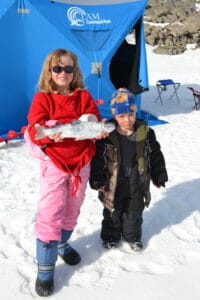
By: Joe Doucette
For those anglers new to ice fishing, you are in for a surprise. It is relaxing, quite easy and much more social than its warm weather cousin. Contrary to popular myth, ice anglers can use pretty much the same gear that they use during the summer with just a few minor exceptions.
To get started in ice fishing, you basically need a rod, terminal tackle, a way cut a hole through the ice and something to skim the ice off of the water in the hole. Anything else, as far as fishing gear goes, is a bonus.
Ice fishing rods are generally around 18 to 30 inches in length and have a small reel loaded with fishing line developed to stay limp even in extremely cold weather. The lighter rods are for fish like perch, while a little stouter rod can handle the strength of the fight that a 20-inch trout puts up. Ice fishing combos start around $20 and go up from there.
In Nevada, for the purposes of ice fishing, the maximum size hole you can cut in the ice is 10 inches. There are two types of hand augers, the spoon and the blade auger. Most prefer the blade as it seems to cut the ice faster and with less effort and is easily sharpened. The trick is to keep the blades sharp and rust free, which is easier to do with a blade auger.
The next question is, where should the hole in the ice be cut? If you are unfamiliar with a lake, the best bet is to either ask someone who knows the lake or look for areas where lots of holes have already been cut. Chances are those holes are there for a reason.
So the hole is cut in the ice. Now what? To target trout, fish in water 6 to 15 feet deep and suspend a hook tipped with PowerBait, worms, corn or marshmallows several feet below the ice about halfway between the ice and the bottom. Place a small sinker about 8 to 10 inches above the hook to help get the presentation down in the water column.
When fishing for perch, head for deeper water. Generally, 25 to 35 feet deep and fish right off the bottom. Using a small soft plastic jig tipped with a piece of worm, place the presentation within a foot of the bottom. Perch bites are very light. Holding the rod will give an advantage in sensing the bite and being able to react while the fish is still on.
The water in the ice fishing hole will soon start to freeze over making fishing difficult. Anglers will use a specially made ladle with holes in it to clear the slush from the hole. You can also use an inexpensive slotted vegetable spoon with the same results.
Other considerations for ice fishing include the very important act of staying warm. Well insulated waterproof boots are a must. For those on a budget, many department stores carry snow boots with a felt liner that are reasonably priced. These aren’t great for hiking, but they work well when standing or sitting on the ice waiting for a strike. Obviously, a good coat and wool gloves are also a must. Your hands are going to get wet, and wool will still hold warmth when it is wet.
A plastic sled to carry your gear onto the ice makes life easier. Sun block and sunglasses are especially important on sunny days as your face will get a double whammy of sun as it reflects off of the snow or ice.
The great thing about taking your family ice fishing is that its simple, there are generally other families around and if the kids get bored fishing they can play in the snow, go sledding or build a snowman.